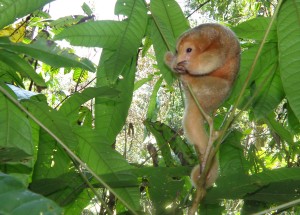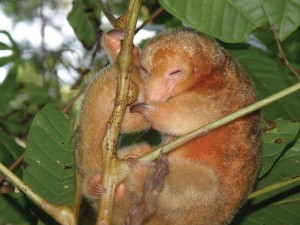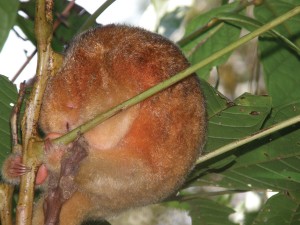Quest for the Silky Anteater
 The Golden Tennis Ball
The Golden Tennis Ball
By Jack Ewing
Back in the 1980s the economy in this part of Costa Rica was still driven by rice farming and cattle ranching. Tourism was something we all knew would come later, but nobody had a clear picture of how it would work. In 1986 the government paved the road between San Isidro and Dominical, and the bridge across the Barú River was completed. Work on the Coastal Highway south of Dominical was in progress and proceeding slowly. A few tourists started filtering into the area, and cabins to accommodate them started appearing here and there. It was the very beginning of a new way of life for the rural community. In a few years it would come to replace farming and ranching as the most important economic activity in the area.

In 1987 we started doing two tours at Hacienda Barú. One was called the Rainforest Experience, and the other the Mangrove Walk. At that time Hacienda Barú had not yet been declared a National Wildlife Refuge, but had a reputation as a private nature reserve. That first year we sold about $300 worth of tours. It wasn’t much, but it was a start, and I really enjoyed guiding them. People liked the hikes, told others, and business increased. The second year we sold $1500 worth of tours, and the following year $4500. We were getting so busy that I couldn’t guide all of the tours, and we sometimes had to turn people away. The time had come to look for more guides.
 We had a man we called the “forest guard” whose job it was to walk around the rainforest and stop hunters from killing the wildlife. His name was Juan Ramón, and he knew the trails, loved nature, and was well acquainted with the flora and fauna. His biggest drawback was that he didn’t speak English, the language spoken by most of the clients. To make up for his lack of language skills I gave him a book called Mammals of the Neotropical Rainforest. When he spotted an animal Juan could show the visitor a picture of it in the book, along with the name and basic information about it. In those days most of the tourists that made it to out-of-the-way places like Dominical were pretty adventurous, and struggling with the language was just part of the adventure.
We had a man we called the “forest guard” whose job it was to walk around the rainforest and stop hunters from killing the wildlife. His name was Juan Ramón, and he knew the trails, loved nature, and was well acquainted with the flora and fauna. His biggest drawback was that he didn’t speak English, the language spoken by most of the clients. To make up for his lack of language skills I gave him a book called Mammals of the Neotropical Rainforest. When he spotted an animal Juan could show the visitor a picture of it in the book, along with the name and basic information about it. In those days most of the tourists that made it to out-of-the-way places like Dominical were pretty adventurous, and struggling with the language was just part of the adventure.
My biggest challenge was to convince Juan that guiding people through the rainforest was a worthwhile activity. He couldn’t understand why anyone would pay to do something so ordinary as hike through a jungle. I tried to explain that the experience was something special for people from other countries. “If you won the lottery and took a vacation to New York,” I told him, “you would happily pay to take a guided tour of the city. But someone who lived there would find it very ordinary.” He kind of got the idea, but not really. It was going to take some more convincing.
That convincing came one day when Juan was guiding a group of four nature lovers on the Rainforest Experience. They came upon a three-toed sloth very near the ground, clearly visible and moving. I found out later that prior to that time Juan hadn’t bothered to point out sloths to people. He couldn’t imagine what anybody would find interesting about one of these plain-colored, lazy mammals. However, he made an exception that fateful day, because the sloth was so obvious, and it was moving. To his surprise the people loved it. They got very excited, took lots of pictures, and one of the visitors gave Juan a $10 tip right on the spot. That was all it took. From that moment forward Juan never walked past any bird, mammal, reptile, or amphibian without pointing it out to the visitors. I believe that it wasn’t so much the money as it was the idea that the rainforest he had thought to be so ordinary had real value for people from other countries. It was an eyeopener for Juan, and his future guiding was filled with enthusiasm and a desire to show his guests every aspect of the jungle. That enthusiasm was contagious, and other workers who later learned to guide just seemed to absorb it.
Soon after we began taking people on hikes, we started putting together a species list. To begin we put every bird and animal that any of the guides had ever seen on the list. The list grew rapidly at first but then slowed to a few birds and animals each year. Our first bilingual guide was an ornithologist named Jim Zook. His presence on the hacienda gave a really big boost to our bird list. Today, 27 years later, the list contains 366 species of birds, 70 of mammals, 33 of amphibians, and 69 species of reptiles.
 In the early 1990s I became interested in a small rainforest mammal called the silky anteater (Cyclopes didactylus.) According to all of the texts that I could find it should exist in this region, but not only had none of our employees ever seen one, none of them even knew what it was. Neither did any of the neighbors. A biologist friend assured me that we most certainly had them on Hacienda Barú, but said the illusive little creatures spent most of their time in the tree tops, and were rarely seen. Our best bet, he said was to look closely at tangled loops of lianas and vines. I decided to make a competition amongst the three guides, Juan, Pedro, and Jim. But I needed a very special prize.
In the early 1990s I became interested in a small rainforest mammal called the silky anteater (Cyclopes didactylus.) According to all of the texts that I could find it should exist in this region, but not only had none of our employees ever seen one, none of them even knew what it was. Neither did any of the neighbors. A biologist friend assured me that we most certainly had them on Hacienda Barú, but said the illusive little creatures spent most of their time in the tree tops, and were rarely seen. Our best bet, he said was to look closely at tangled loops of lianas and vines. I decided to make a competition amongst the three guides, Juan, Pedro, and Jim. But I needed a very special prize.
Up until 1989 and the printing of the first edition of Birds of Costa Rica, the only field guides available were Birds of Panama and Birds of Mexico. These books were good, but were incomplete for Costa Rica. The entire first printing of Birds of Costa Rica was purchased by the Audubon Society and sold only to their members. I doubt if a single copy made it to Costa Rica. With the third printing in 1992 a few copies of the book began to appear in the hands of Costa Rican guides and bird watchers, but the book was still a rare treasure and much coveted by bird lovers and people who worked in tourism all over the country. A friend of mine from the United States, who was a member of the Audubon Society, managed to acquire two copies and bring them to me when he came to visit. I kept one, which I still have to this day, and offered the other as the prize in the quest for the silky anteater. The first guide to spot one would become the proud owner of Birds of Costa Rica. It was the ideal incentive.
The silky anteater is the most charismatic animal I know. Its golden colored fur is soft and fluffy, and frames the sweetest face anyone can imagine. Sometimes called the “Golden Tennis Ball” its favorite sleeping position is rolled up in a ball. This position makes it extremely difficult to spot The round form doesn’t resemble any type of animal, and the coloring blends well with the greens, yellows, and browns of the rainforest. In addition, the silky anteater is shy, nocturnal, and lives in the treetops, all of which make sightings rare. It prefers trees with ample liana growth, and when seen from the ground is often asleep in a low-hanging tangle of these thick vines. Limited research suggests that the species is more prevalent than the sparse amount of sightings suggest. As the name implies it feeds almost exclusively on ants, especially those that live in hollow stems. Using it’s sharp front claw the silky anteater splits open a hollow stem and laps up the ants with its long, sticky tongue. Those sharp front claws are also a great deterrent to any animal of bird that might have any ideas of harming the furry little animal. The back feet and the prehensile tail both have a powerful grasp, thus freeing up the front feet to slash out at attackers.
One day in February of 1974, Juan Ramón, beaming from ear to ear, returned from a tour with three very happy visitors. They had seen a silky anteater. “Get your camera boss,” he said. “Its probably still there.”
Away we went, camera in hand. About 30 minutes later we came to a tangled loop of lianas hanging from a rainforest tree. And there was the golden tennis ball resembling various shades of dry leaf matter. How Juan spotted it, I will never know. But there it was. I took pictures until I ran out of film. We headed for home content that the mysterious little animal really existed on Hacienda Barú. But we were in for another surprise.
Arriving at the house we found Pedro who had returned from guiding another tour and was waiting for us with the news that he had spotted a silky anteater, about one kilometer from the one we had just photographed. I was all out of film, but Juan, Pedro, and I went to have a look anyway. Pedro’s golden tennis ball was sleeping in another tangle of lianas at a different location. It looked like an exact duplicate of the first one. What an amazing coincidence. After searching and hoping for so long, and then to have both guides sight the charismatic little mammal on the same afternoon.
Since there was a prize involved we discussed the timing. It turned out that Pedro had sighted his silky anteater at about 1:30 PM and Juan Ramón about an hour later. Pedro became the proud owner of Birds of Costa Rica.
It was seven years before the golden tennis ball made another appearance, this time on the Night in the Jungle tour. Then we had to wait eleven years before sighting it on a Rainforest Experience hike. Only two years later, on April 3 of this year, I was away from the office and received a call on my mobile. Guides Ronald and Olman had just returned from a Flight of the Toucan zip line tour. “We need a good camera,” they told the receptionist excitedly. “We spotted a silky anteater, and it’s probably still in the same spot.” She called me, explained the situation, and asked permission to use my camera. I readily agreed.
When I returned and saw the photos of the silky anteater, it brought back memories of that first one. Though this one was in a small tree rather than a tangle of vines, it was every bit as cuddly and charismatic as I remembered it to be. I hope you readers agree.
